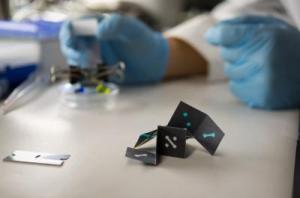
The sensors can be printed out on an office printer
Inspired by the paper-folding art of origami, chemists at The University of Texas at Austin have developed a 3-D paper sensor that may be able to test for diseases such as malaria and HIV for less than 10 cents a pop. The sensors can be printed out on an office printer, and take less than a minute to assemble.
Such low-cost, “point-of-care” sensors could be incredibly useful in the developing world, where the resources often don’t exist to pay for lab-based tests, and where, even if the money is available, the infrastructure often doesn’t exist to transport biological samples to the lab.
“This is about medicine for everybody,” says Richard Crooks, the Robert A. Welch Professor of Chemistry.
One-dimensional paper sensors, such as those used in pregnancy tests, are already common but have limitations. The folded, 3-D sensors, developed by Crooks and doctoral student Hong Liu, can test for more substances in a smaller surface area and provide results for more complex tests.
“Anybody can fold them up,” says Crooks. “You don’t need a specialist, so you could easily imagine an NGO with some volunteers folding these things up and passing them out. They’re easy to produce as well, so the production could be shifted to the clientele as well. They don’t need to be made in the developed world.”
The results of the team’s experiments with the origami Paper Analytical Device, or oPAD, were published in October in the Journal of the American Chemical Society and this week in Analytical Chemistry.
The inspiration for the sensor came when Liu read a pioneering paper by Harvard University chemist George Whitesides.
Whitesides was the first to build a three-dimensional “microfluidic” paper sensor that could test for biological targets. His sensor, however, was expensive and time-consuming to make, and was constructed in a way that limited its uses.
“They had to pattern several pieces of paper using photolithography, cut them with lasers, and then tape them together with two-sided tape,” says Liu, a member of Crooks’ lab. “When I read the paper, I remembered when I was a child growing up in China, and our teacher taught us origami. I realized it didn’t have to be so difficult. It can be very easy. Just fold the paper, and then apply pressure.”
Within a few weeks of experiments, Liu had fabricated the sensor on one simple sheet using photolithography or simply an office printer they have in the lab. Folding it over into multiple layers takes less than a minute and requires no tools or special alignment techniques. Just fingers.
Read more . . .
Bookmark this page for “Paper Sensor” and check back regularly as these articles update on a very frequent basis. The view is set to “news”. Try clicking on “video” and “2” for more articles.







